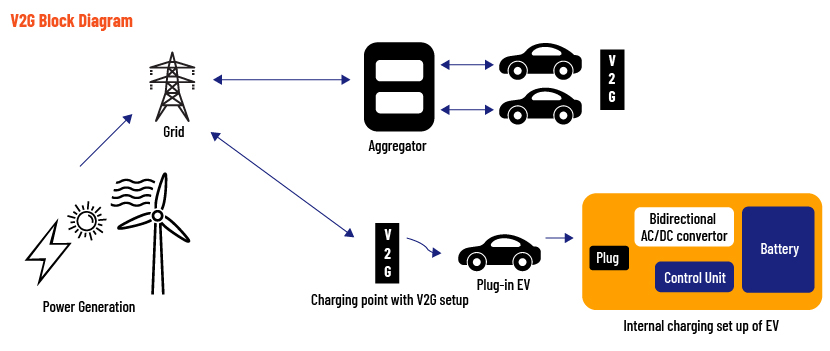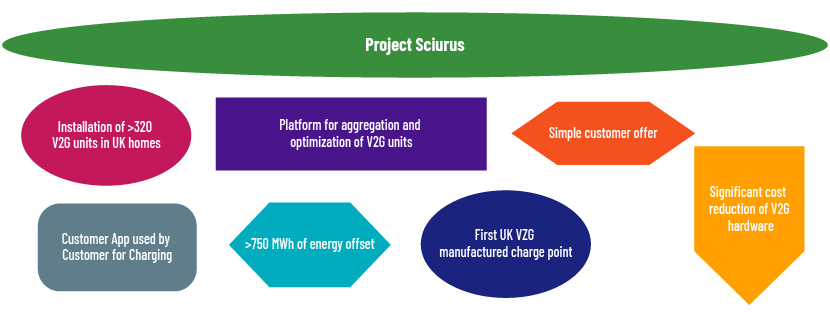Published on October 17, 2023 by Rajnish Kumar Sinha
To address the Climate concern, countries, organizations, institutions are devising different ways to address it and make world a better place to live. Multi-front developments are happening like De-carbonization, Energy efficiency etc. Renewable energy resources role to address the climate issue is going to be significant as can be seen from various governments, organization, institutions investing heavily into it. Although, they are promising source of energy but they require energy storage facility and can cause volatility into the grid infrastructure.
In order to address the above issue, one solution can be using the Electric vehicle batteries as short term energy storage system. As Electric Vehicles (EVs), whose history started in 1832, but whose significance to address climate issue have gained grounds now, are coming up in large numbers. And it is expected that by 2030 there could be around 250 million EVs globally. Its battery capacity can be used to store energy and give back to grid when required by a concept called “Vehicle to Grid (V2G)”.
V2G has the potential to not only address the storage issue but can also help in bringing stability to the energy system. Although at a nascent stage, its consideration can prove to be a game changer if implemented properly. Let’s find out what it is, how it is helpful and what developments technological and regulatory are happening in this field.
What is Vehicle to Grid?
Vehicle to Grid abbreviated as V2G is a technology that enables energy to be pushed back to the power grid from the battery of an electric car. A vehicle-to-grid charging device absorbs electricity from the car battery and simply just pushes it back to the grid, where it continues its journey to the nearest location where it’s needed.

Mainly, the idea behind vehicle-to-grid is similar to regular smart charging. Smart charging, also known as V1G(unidirectional) charging, enables us to control the charging of electric cars in a way that allows the charging power to be increased and decreased when needed.
Vehicle-to- grid goes further ahead and enables the charged power stored also be momentarily pushed back to the grid from car batteries to balance variations in energy production and consumption.
Benefits of V2G
Although at project/demonstration level growth happening and is moving towards commerciality, the benefits that can be achieved are as follows:
-
Emergency response: V2G technology can used as an emergency response tool when Electric Vehicles numbers increase on the road. As in extreme weather conditions these days power outages happen, electric vehicles can maintain power for basic needs such as hospitals etc. until the problem is fixed. This will make the electricity system less vulnerable and less dependent on external conditions.
-
Balance of Grid: The grid needs to have production and consumption balance in order to work properly. The EVs can help to stabilize grid when there is gap of consumption and production i.e. charging when production is high and giving back when consumption is high.
-
Car manufacturers: The Electric Vehicle which is available at a premium to fossil fuel vehicles can be shown to have the V2G advantage that adds value and eases customer pocket of running the vehicle. As studies have proved that it can prove to be revenue earning source while running the vehicle.
-
OEMs business opportunity: Vehicle to Grid equipment manufacturers will have opportunity to tap into the V2G equipment market.
-
Fleet owners and Individuals: In case of Variable tariff scenarios, the individuals and fleet owners can earn revenue by charging when tariff is low and giving back to grid in peak requirement condition when tariff goes high.
Pilot projects undertaken:
Some recent pilot projects undertaken to prove its technical viability:
1. Project Sciurus, UK

-
Summary – This project involved OVO Energy, Cenex, Nissan and Indra. This project was addressing both technological and business case to prove that V2G was economically, societally and environmentally significant. It involved experts from energy, transport and infrastructure to develop a V2G solution by keeping V2G units at home in UK.
-
Result- Using the data from 2020, the project found that using the optimisation model the average annual revenue that could be made with a V2G charge point was £340.
2. Roanoke Electric Cooperative, USA
-
Summary - A V2G pilot study was conducted using Roanoke Electric Cooperative and Fermata Energy in North Carolina with a Nissan LEAF vehicle and Fermata Energy’s bidirectional charger. It was conducted to assess use of V2G as additional revenue earner using the batteries of Electrical vehicles parked at home. And how it helped the Roanoke’s member owners.
-
Result - This pilot project showed that there was additional value of V2G, it helped to manage load and saved not only the utility but also the ratepayers money.
3. Beverly, Massachusetts Electric School Bus Pilot, USA
-
Summary – National Grid did a pilot in Beverly Massachusetts, where it used a Highland Electric school bus which was built by Thomas and powered by a Proterra battery system to check if it helped reduce peak demand.
-
Result – There were 30 different demand response event, during the summer it was tested, that the electric school bus responded to. The bus discharged about 3 MWh of electricity back to the grid in 35 hours which is equal to powering 100 homes for 1 day.
Although pilot level work has been done at many places but it is not empty of real time examples:
Japan
-
The Tohoku earthquake and Fukushima Daiichi nuclear disaster in 2011 left Japan with the need for energy. In order to alleviate the power shortage, Nissan used 66 Leafs to provide power until the grid was stabilized.
-
Nissan also sent an additional group of Leafs to Tokyo following Typhoon Faxai in 2019.
South Australia
-
South Australia is the only jurisdiction in Australia that has provided approval for EV chargers to be installed in bidirectional mode in residential settings but the technology has been trialed there and elsewhere.
-
The first of the Wallbox Quasar chargers has already been installed at the Ballycroft Vineyard and Cellars in the Barossa Valley where owner Joseph Evans has used the V2G technology alongside rooftop solar to not only eliminate his power bill, but profit from the energy he feeds back into the grid.
Development on Technical and Regulatory front:
The pilot studies have proved the viability of the concept and it has been implemented also in some cases. Now commerciality needs to be achieved for which few more technical answers can add further advantage like:
-
There are different manufacturers of V2G Chargers leading to availability of it in different shapes, sizes, capacity etc. The chargers helps to bypass the AC DC issue during V2G operation, in some cases vehicles come with that facility. So lot of advancement has been done but there is scope for improvement.
-
There are not many manufacturers providing V2G compatibility vehicles. Few companies exist like Nissan with Nissan Leafs and Nissan e-NV200, Mitsubishi with Outlander PHEV and iMiev models. Some other models are Peugeot iON and Citroën CO. As more manufacturers will come up with their vehicle models it will increase competition and will increase choice for consumer and may reduce price.
-
There are questions like rapid charging and discharging can lead to battery damage. Some support it and some deny. Further research to come to conclusion can help to avoid such misconceptions and if it’s true can help to find solution.
For any new concept to take shape and gain ground, it is necessary to have effective policy and regulation in place. Although suggestions are coming from different studies and consulting bodies but a lot of work is still required. Example of initiative on policy front is there is USA as shown below:
IIJA (The Infrastructure Investment and Jobs Act (IIJA)) V2G Policies
-
Surface Transportation Block Grant Program (Section 11109): The multi- billion dollar program includes EV charging and V2G infrastructure consideration.
-
Grants for Charging and Fueling Infrastructure (Section 11401): In order to be eligible to get grants applicants are required to show their V2G initiative taken.
-
Smart Grid Investment Grants or “Deployment of Technologies to Enhance Grid Flexibility” (Section 40107): This $3.5 billion grant for smart grid technologies includes V2G, a DOE grid modernization program including V2G.
-
Study of Codes and Standards for Use of Energy Storage Systems Across Sectors (Section 40111): The codes and standards for energy storage will also analyze V2G case for integration into the scheme of things.
-
National Electric Vehicle Formula Program: A $ 5 billion National EV charging Corridor program wherein DOE and DOT have to consider V2G integration among other factors into developing guidelines.
-
Joint Office of Energy and Transportation: A new office to be run jointly by DOE and DOT which is made to plan, co-ordinate and implement technical assistance on V2G issues.
Similar initiatives and policies will be required to be put in place for industry to bring the tools to market, customers to utilize the concept so that overall objective is achieved.
Conclusion:
The concept of Vehicle to Grid is at its nascent stage considering that commerciality of the same is also dependent on the widespread use of Electrical Vehicles, availability of infrastructure and favourable policy and regulations. The technical enhancement will further help stamp its authority and acceptability in industry. Moreover, policy initiatives and favourable regulations will help to spread the awareness and acceptability among masses. As it is work in progress and other will be competing with other initiatives, the sooner the effort of bringing industry, customer, equipment manufacturer and utilities are taken, the better will be the fate of establishing its commerciality.
How Acuity Knowledge Partner can help:
We are the preferred partner for Energy solutions. With a talented pool of experts, we cater to companies involved in Oil & Gas and Power sector, supporting them with in depth research, analysis, investment decision making, strategy etc. in today’s ever changing business environment. We cater from conventional Oil & Gas/ Power solution requirement, to solution related to alternative sources of energy towards which the world is progressing.
Sources:
-
Vehicle-to-Grid (V2G): Everything you need to know (virta.global)
-
OMI White Paper | Vehicle to Grid (V2G) in India | Jun 2021 - designed (olawebcdn.com)
-
Advancing-V2G-Technology-Adoption.pdf (electrificationcoalition.org)
Tags:
What's your view?
About the Author
Rajnish has more than 14 years of experience in Energy industry. It includes Oil & Gas field experience to working on various strategic and management research projects. Apart from Conventional Oil & Gas industry his expertise also includes Alternative Fuels and Power sector. He holds an MBA degree in Oil & Gas Management from University of Petroleum and Energy Studies (UPES) and Applied Finance Certification from IIM-Calcutta.
Like the way we think?
Next time we post something new, we'll send it to your inbox








